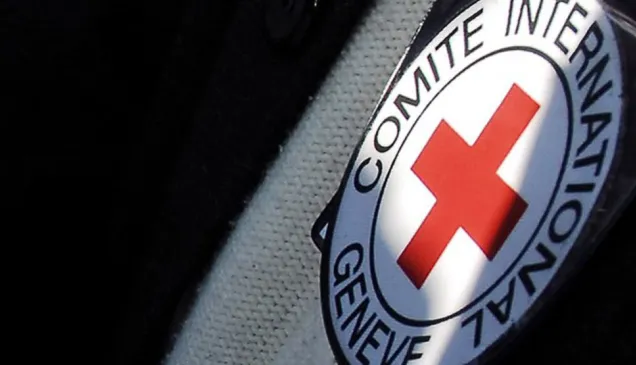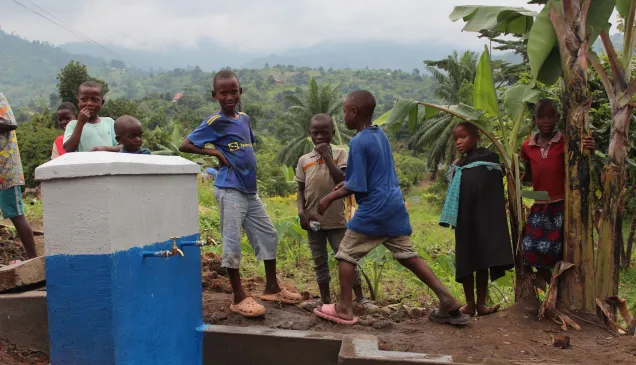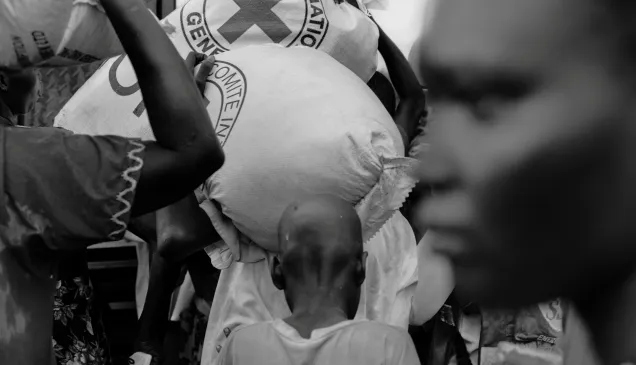Influencing behavioural change for better prevention of sexual violence in armed conflict
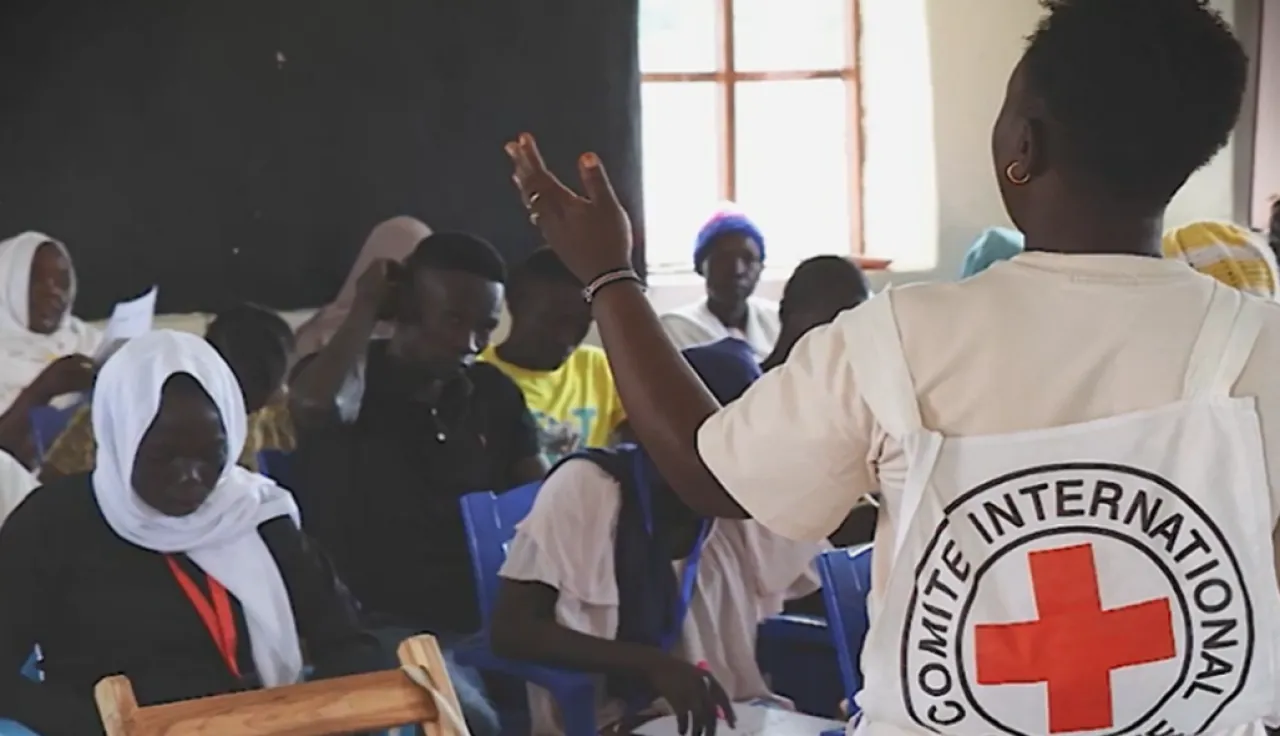
What is the Prevention of Sexual Violence Programme (PSVP)?
The ICRC works to influence the behaviour of weapon bearers, civilian authorities, and communities to prevent sexual violence in armed conflict and reduce the harm experienced by victims/survivors. Over the last decade, the ICRC has conducted in-depth operational research to better understand ‘what works’ when it comes to preventing sexual violence.
As part of its work to address sexual violence in armed conflict, in 2022 the ICRC launched the Prevention of Sexual Violence Programme (PSVP), a multi-country, multidisciplinary and results-oriented programme which aims to influence behavioural change for improved survivor-centred prevention. The PSVP focuses on fragile and conflict-affected operational contexts where it seeks to address harmful, underlying attitudes and practices according to two models: Model A with weapon bearers and Model B with communities.
Model A: Frontline prevention with weapon bearers
Based on its operational expertise and dialogue with state and non-state armed forces, the ICRC has found that strategic discussions about IHL prohibitions on sexual violence are too often disconnected from what sexual violence can look like in the battlefield, the experiences of weapon bearers, and their own understanding of what they can do to prevent it.
The PSVP’s work with weapon bearers aims to reduce perpetration of sexual violence by state and non-state armed forces using a specialized training package: Be Prepared to Help Weapon Bearers Prevent Sexual Violence. In addition to increasing weapon bearers’ understanding of the causes and consequences of sexual violence for civilians, the ICRC has successfully raised awareness of how perpetration harms weapon bearers themselves. Through scenario-based training and contextually relevant messaging, the ICRC also provides tools that can be used, at the unit level, during training as well as the planning and conduct of operations, to reduce the risk of sexual violence.
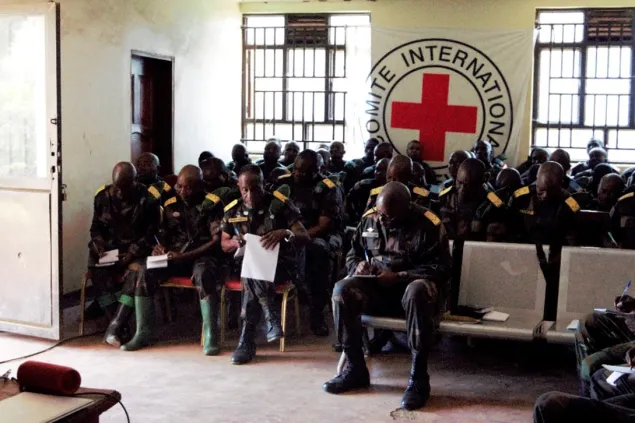
Senior commanders from the Armed Forces of the Democratic Republic of Congo operational unit stationed in South Kivu participate in an ICRC training on frontline prevention of sexual violence (Kalehe, DRC, September 2024)
Model B: Addressing stigma with communities
The PSVP also works to bolster community resilience by tackling stigma against victims/survivors through outreach. This model aims to reduce victims/survivors’ exposure to further violence by reinforcing supportive behaviours using specific tools and messaging the ICRC has co-developed with survivor-led and survivor-advocate organisations to counteract the harmful impact of stigma.
Together with International Red Cross/Red Crescent Movement staff and volunteers, the ICRC has trained community influencers to engage with community leaders, including law enforcement, religious authorities, and healthcare workers. Trainings focus on how to integrate stigma reduction into their daily interactions with community members to further amplify the positive impact of these messages. By challenging harmful norms, community leaders and the Red Cross/Red Crescent Movement have contributed to building safer environments for victims/survivors.
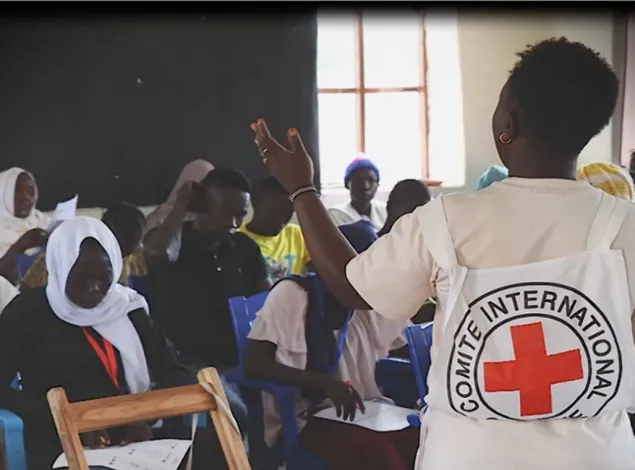
The ICRC hosts an awareness session on stigma reduction with displaced victims/survivors (Raja, South Sudan – 2024)
Is it possible to change attitudes and behaviours about sexual violence?
Pre-existing attitudes and behaviours can be influenced to better prevent and/or reduce risks of sexual violence. Changing behaviour, however, means overcoming cognitive biases (i.e., the way individuals or groups may interpret events, facts, and other people based on their unique beliefs and experiences). By adapting UNICEF’s 2019 Behavioural Change Model, the ICRC has identified four key drivers of behavioural change (interest, attitude, knowledge, and self-efficacy) which can help to increase restraint and existing capacities to prevent sexual violence and further harm
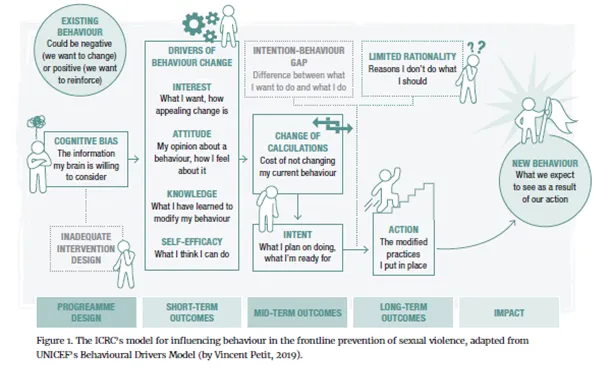
Through the PSVP’s monitoring and learning tools, the ICRC works to closely track and measure the:
- Change of calculations: The way that actors of influence – including community leaders and members – make decisions regarding sexual violence and what could cause them to change their actions
- Intent: The extent to which these actors are willing to make a commitment to implementing these changes in their behaviour
- Action: How they will promote concrete actions that lead to IHL-compliant behaviour that reduces human suffering in war (e.g., the prevention of sexual violence)
How can we measure what hasn’t happened?
Initial findings from the first few years of the PSVP’s implementation confirm it is indeed possible to improve and measure short and mid-term prevention outcomes. Through the PSVP, the ICRC has strengthened its methodology and its ability to improve and measure the impact of its frontline prevention efforts. That led to a positive behavioural change in shifting the blame to perpetrators instead of victims, and a notable reduction in misconceptions and about sexual violence. Evidence has also underscored what types of ‘messengers’ and ‘methods’ are most effective in shifting group norms and behaviours around the prevention of sexual violence.
Weapon bearers: The role of commanders and instructors
During the first two years of the PSVP’s implementation, a new frontline training package, Be Prepared, was piloted by several ICRC delegations through formal training sessions and/or their ongoing protection dialogue and awareness-raising reaching more than 2,600 members of state and non-state armed groups. Preliminary data from these engagements confirm weapon bearers perceive the ICRC to be a credible source of information on the prevention of sexual violence which has left to an increase in their interest in preventing sexual violence (20% increase) and knowledge of how to reinforce this prohibition (51% increase).
However, evidence also shows that successful prevention of sexual violence is highly contingent upon commanders’ commitments to reinforce key messages on the topic before and after ICRC trainings as well as willingness to integrate the prohibition on sexual violence in their rules, regulations, and procedures. This is complicated by a training and trust gap whereby less than 15% of all military instructors who have engaged with the PSVP feel equipped to train their troops on the topic and less than 68% of the rank and file believe their commanders would stop sexual violence if it were happening.
Communities: Outreach to promote help-seeking behaviours
Communities are deeply impacted by sexual violence during armed conflict but – with the right support – can also be an integral part of the solution. In 2024 alone, the ICRC and its RC/RC Movement partners have trained more than 633 community influencers who have conducted thousands of outreach sessions on stigma reduction reaching more than 150,000 community members – including local authorities, religious leaders, teachers, youth, and service providers – across multiple countries.
Through its engagement with communities affected by sexual violence, the ICRC has learned the messenger matters; even the most powerful survivor-led messages will not resonate unless they are adapted to the realities of each target audience (e.g., elders vs. youth, men vs. women, etc.) and delivered by community members who are credible ‘messengers’ in the eyes of their peers. Notably, more than half of all ICRC-trained community influencers are women while more than one-third are adolescents and youth between the ages of 14 and 30.
Data shows the ICRC’s contextually adapted community outreach activities have significantly contributed to positive behavioural change for better stigma reduction. Overall, community participants have:
- Committed to support victims/survivors in 98% of the sessions
- Committed to reject perpetrators of sexual violence in 96% of the sessions
Perhaps most importantly, community outreach has a tangible impact on help seeking behaviour by increasing awareness about services and reducing barriers to access like stigma. In locations where the ICRC and its RC/RC Movement partners are implementing community outreach, victims/survivors are 4.5 times more likely to seek help.
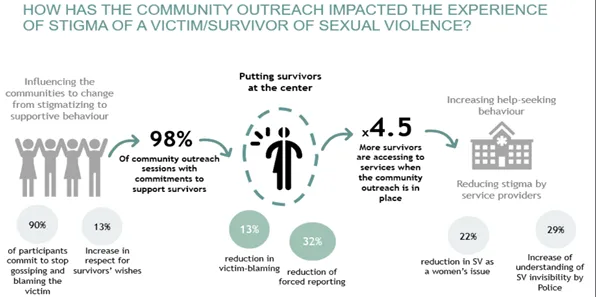
What`s on the horizon for the PSVP?
These findings highlight the PSVP’s strong potential for generalizability through adaptation for use by other humanitarian organizations including Red Cross/Red Crescent Movement partners (Model B) as well as military instructors (Model B). In parallel, the ICRC will continue scaling up its prevention efforts by applying some of the lessons learned from the PSVP to preventing a wide range of IHL violation through behavioural change.
For more information:
- Promising Pathways for the Prevention of Sexual Violence (2024)
- Promising Pathways for the Prevention of Sexual Violence (2023)
The ICRC is grateful to the Irène M. Staehelin Foundation for its continued support of this vital work.

